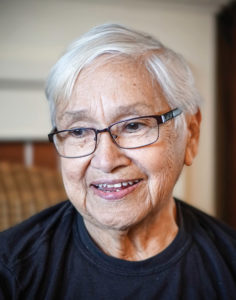First Person Radio Signs Off the Air
By ELAINE SALINAS
The final segment of First Person Radio (FPR) aired on KFAI Radio in Minneapolis on February 14th, 2018, forty years after it originated as The Native American Program on KUOM-AM, the University of Minnesota”'s radio station. First Person Radio can best be described as a labor of love coupled with a commitment to produce timely and accurate news and information about the American Indian community to counter the many misrepresentations and inaccuracies perpetuated about Native people in the major media. Not surprisingly, the program was birthed by a volunteer group of bold young Indian University students organized by a seasoned and visionary journalist, Laura Waterman Wittstock. Laura, from the Seneca Nation in New York, had worked with the pioneering Native American Press Association in Washington, D.C. in the early 1970s. First Person Radio was the first work of MIGIZI Communications.
At the time of First Person Radio”'s founding, the one hundred plus Indian newspapers that were being published around the country were suffering slow deaths, victims of the rising costs of paper and printing and the plummeting revenues from advertising. First Person Radio was seen by its aspiring group of founders as a viable, alternative way to get reliable news about Indian country out to Indian people and non-Indian people alike via the airwaves, a profound leap in thinking at the time. First Person Radio, in fact, became the first nationally-distributed Indian radio news program in the country with the help and assistance of other key contributors including Gary Fife, Michael Dalby, Andy Marlowe, Bill Parker, and others.
Over time the listening audience grew and the program was picked up by subscriber stations (primarily public but also tribal) throughout the Upper Midwest region and throughout the country. In today”'s high-tech environment, it is almost impossible to grasp that the original means of distribution was 7-inch reels sent through the mail. The program was later uploaded through a satellite system at Minnesota Public Radio.
The half-hour First Person Radio program served as a dependable and accurate source of Indian news and information thus filling an Indian news vacuum for thousands of Indian and non-Indian listeners for the next fifteen years. It captured current events from an indigenous perspective, featured the music of indigenous artists who often had no other outlets, and dug deep into issues affecting Indian people through interviews with leading voices from throughout Indian country. First Person Radio”'s excellence in programming was recognized in 1992 when it was awarded the National Headliner Award – Best Radio Documentary for the series, Coming to America.
Equally impactful, First Person Radio trained a generation of fearless young Indian journalists whose early and selfless contributions to Indian radio ignited a flame for breaking the mold and contributing back to community. Included among this group was Hattie Kauffman Wing, who became a national news correspondent; David Larsen, an educator and former Tribal Chairman for the Lower Sioux community; Reid Raymond, the first Indian attorney employed by the Hennepin County Attorney”'s Office; and Jackie Dionne, the youngest intern with First Person Radio now serving as the American Indian Health Director for the Minnesota Department of Health.
When First Person Radio was forced to sunset in 1992 due to rising production and distribution costs and declining support for public radio across the country, its legacy continued. Laura Waterman Wittstock, founder of MIGIZI Communications, took advantage of the large reservoir of knowledge and experience gained through First Person Radio to place the tools of communications in the hands of the younger Indian youth. MIGIZI”'s Achievement Through Communications, and Native Academy programs became the first community-based programs in the city to give access to state-of-the-art technology to American Indian youth, thus closing the digital divide for hundreds of youth who lacked access to computers in their homes and other community settings. Today, this legacy continues through MIGIZI”'s youth-run social media enterprise that provides an opportunity for Indian young people to tell their stories and serve the community through training in video production, marketing, and enterprise management.
Laura Waterman Wittstock served as President of MIGIZI from 1986 to 2004 when she retired from the organization. Her life-long passion for Indian journalism motivated her to resurrect First Person Radio in 2010 as a one-hour Indian current events program on KFAI Radio. Over the course of the next eight years, she grew a loyal listening audience that included former and new listeners from throughout the metro area and across the country who are as hungry today as they were back in 1977 to hear news and stories from a uniquely indigenous perspective.
Laura”'s last two years of producing and hosting First Person Radio demonstrated her indomitable spirit and fortitude as she continued to meet the demands of the weekly program despite declining health and limited mobility, conditions that ultimately caused her to retire the program in February 2018.
It is only fitting that the final segment of First Person Radio that aired on February 14th was a tribute to Laura and her legacy. The segment included co-host Roy Taylor and guests Miguel Vargas, Rhianna Yazzie, and Wendy Gasco, Chair of the KFAI Board ”“ friends and colleagues all present to honor the woman and work of Laura Waterman Wittstock. Although Laura was able to join for only a short time, those gathered shared events and stories from First Person Radio”'s history, played excerpts from past programs including a 2012 report from the 150th Anniversary of the hanging of the 38 Dakota in Mankato conducted by Laura in below zero weather; and included some of Laura”'s favorite music from indigenous artists Annie Humphreys and John Trudell, Floyd “Red Crow” Westerman and others. The program was a loving and moving tribute to a groundbreaking Indian journalist.
Elaine Salinas is President and Chief Professional Officer at MIGIZI (since 2004), an educator for over 35 years in public and alternative schools, and an enrolled member of the White Earth Band of Ojibwe.












When someone writes an post he/she retains the plan of a user
in his/her brain that how a user can understand it. So that’s why this piece of writing is amazing.
Thanks!
[…] Wittstock was president of MIGIZI Communications from 1986 to 2004, according to a story in The Alley, written by Elaine Salinas, then MIGIZI’s president. MIGIZI’s […]